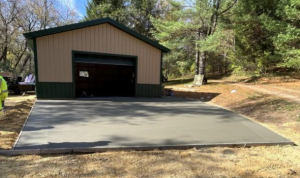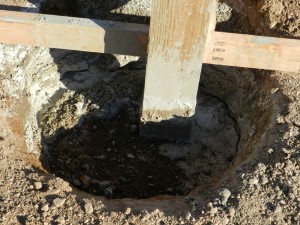Rachel, one of the Hansen Pole Buildings Designers recently took a call from a client who was disappointed because we did not provide the concrete for their new pole building kit package.
Most people are familiar with Sakcrete® readi-mix concrete. There is probably not a lumberyard in America which does not have it available for sale.
Sakrete® offers a variety of concrete mixes for most any application including creating countertops, setting fence posts, anchoring poles, pouring slabs, walkways or footings.
In addition to the general purpose High Strength Concrete Mix, Sakrete® offers a number of specialty concrete mixes including 5000 Plus Concrete Mix. 5000 Plus is ideal for structural applications which demand high compressive strengths such as slabs which will be subjected to heavy loads, commercial traffic or warehouses subjected to forklift traffic..
 In a hurry? Choose Sakrete® Fast Setting Concrete Mix. This product combines the convenience of high strength concrete mix with a set time of just 30 minutes. Simply pour the product in the hole, add water and install posts. Since this is a fast setting concrete mix, a pole building can be framed the same day posts are installed.
In a hurry? Choose Sakrete® Fast Setting Concrete Mix. This product combines the convenience of high strength concrete mix with a set time of just 30 minutes. Simply pour the product in the hole, add water and install posts. Since this is a fast setting concrete mix, a pole building can be framed the same day posts are installed.
Sakrete® offers Maximizer, a high-yield concrete ideal for reducing the number of bags needed to complete a job. An 80 lb. bag yields 60 percent more volume than any other standard 80 lb. concrete mix. A job which would require 40 bags of regular concrete would only require 24 bags of Maximizer.
Most familiar, as well as most available is the Sakrete® general purpose High Strength Concrete Mix. When mixed per the manufacturer’s instructions, this mix affords a compressive strength of 4,000 psi (pounds per square inch) at 28 days.
The instructions are: Empty the contents into a mortar box, wheelbarrow, or mechanical mixer. When mixing by hand, form a crater for adding water. Add water a little at a time. Avoid a soupy mix. Excess water reduces strength and durability and can cause cracking. A 60 lb. bag should be mixed with three quarts of water, an 80 lb. bag four quarts.
Now the realities of using bagged concrete for post frame building footings….
It is not unusual to have concrete encasements of 24 inches or larger in diameter and 18 inches or more in depth, in order to prevent building settling and uplift issues. One hole this size would take 4.71 cubic feet, or about 700 lbs. of concrete! Even a very small building with 18 inches of diameter and depth takes 2.65 cubic feet or about 400 lbs. of concrete.
With either 60 or 80 lb. bags, it is going to take a lot of bags! An average building could easily have 20 posts, and if looking at 700 lbs. of concrete per post, we are talking about 7 TONS of concrete (3-1/2 yards).
Ignoring the huge number of bags involved, there are some other realities.
Ever looked at the pallets of readi-mix bags at the lumberyard? Take a peak, next time. Notice how many of them are broken or leaking.
Due to weight, it may very well mean another delivery and another delivery charge. Trucks do not run for free.
Bags can (and will) break when being handled during delivery, unloading and being moved around the jobsite. It is going to happen, just plan on it.
From experience, lots of projects are not begun immediately after delivery. It is not unusual for delays of weeks, or even months before actual construction begins. Improperly stored, bags can get wet or absorb moisture and become solid before time for use. This equals a total waste of money, other than the chunks of concrete make for solid backfill.
Then there are the builders who insist upon throwing the entire bag (usually including the bag) into the hole. Their idea is ground water will cause the readi-mix to harden. Why does this not resemble the manufacturer’s instructions?
Readi-mix must be mixed thoroughly and evenly. How does mixing over 200- 60 lb. bags of Sackrete® by hand sound? Add too much water (three quarts exactly per 60 lb. sack) and the strength is reduced.
Use too much? As holes are always perfectly round (not), it is going to happen.
Save time, effort and money. Often all three can be saved by having the local pre-mix concrete company deliver concrete for holes (even if a “short load” fee is charged), as opposed to mixing on site.
And to think, the client sounded frustrated and disappointed we did not provide the concrete.








